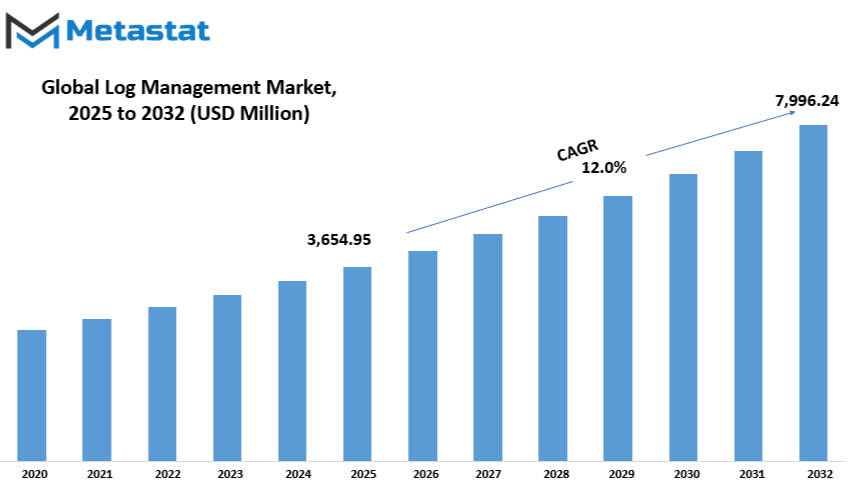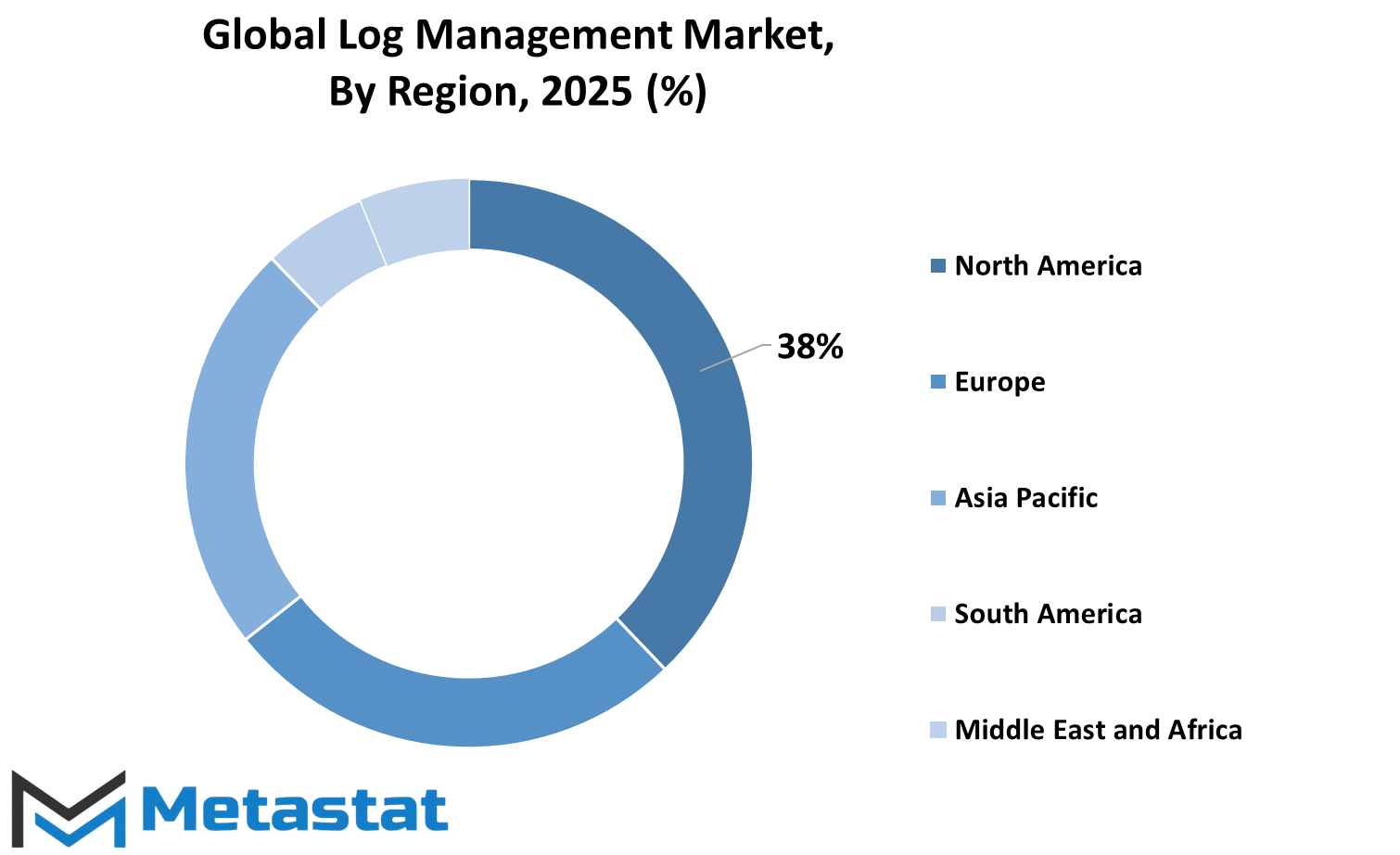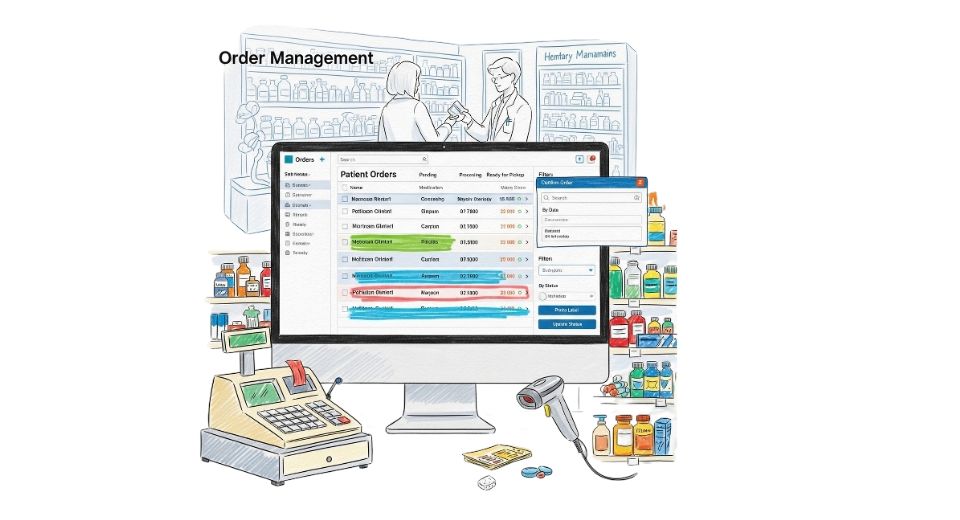MARKET OVERVIEW
The Global Log Management market is likely to transform into something entirely different from its traditional form. From being a support system for monitoring, diagnostics, and compliance, the future will see it become a much livelier and more strategic driver of the comprehensive IT operations and cybersecurity ecosystem. It will not only track events or manage alerts as data volumes explode; it will also become a proactive driver in enterprise resilience, automation, and cross-departmental intelligence.
Instead of cataloging isolated system monitoring, the industry will shift toward developing integrated environments with fluently interactive log data as part of business analytics, risk assessment models, and AI-based automation tools. Enterprises will no longer inject log data merely to catch the problems after-the-fact but will be engaging on the establishment of predictive systems that can analyze trends, correlate information from multiple platforms, and signal before things worsen. Such new modes will require the availability of fast, scalable, as well as flexible platforms to respond to emerging security, regulatory, and business demands.
Likewise, there will be application of Global Log Management beyond IT-centric applications-the newest application would come from the growing use cases in healthcare, manufacturing, and finance, where contextual intelligence from logs will be needed to improve operational workflows, make better decisions, and even discover new revenue opportunities. Log data would, for instance, be utilized in hospitals to audit patient access, improve care coordination, and maintain the regulatory safeguard. Log data will be integrated with their production systems to ensure uptime and quality control at every stage.
Much of this will apply to how organizations approach storage as well as access to logs. Today, real-time, event-driven architectures will replace the traditional storage models that enabled systems to trigger immediate, results-based actions according to defined parameters. This would reduce the very latency responses faster in mitigation strategies. Moreover, the Global Log Management market in the future will depend largely on how well the vendors incorporate privacy-by-design principles. With rising scrutiny across the globe around data governance, log management tools will have to be well featured to cater to secure data handling, anonymization, and permission-based access.
Customization will also be important. Solutions with the same principles will be phased out gradually because companies are going to demand tailored platforms that are capable of catering to industry needs, compliance frameworks, and scale goals. Open-source frameworks may gain momentum in this regard, providing much more control and integration capabilities for enterprises wanting to build proprietary solutions.
Global Log Management market is estimated to reach $7,996.24 Million by 2032; growing at a CAGR of 12.0% from 2025 to 2032.

GROWTH FACTORS
The global log management market is on a steady rise on the shoulders of two primary drivers. First, companies are increasingly adopting real-time log monitoring given the rising incidents of cybersecurity threats. With threats becoming frequently occurring and damaging, organizations cannot afford delays in the detection and response of the security breach. Suspicious activities can be monitored and tracked in real-time to allow organizations to intervene before an issue escalates into a full-blown operation. Closely tied to this is the stricter data protection and compliance regulations that are creeping in. Governments and industry players are setting the bar higher on what standard to attain in keeping record of these companies' digital activity, thereby forcing the companies to retain log data for extended periods and keep retrieve accessibility. These provisions for transparency and accountability have, therefore, translated into a high demand for log management systems that can retain, sort, and analyze enormous amounts of data.
Increasing demand along with low market penetrating capability proves to be a concern. The high investments in establishing and maintaining advanced log management systems are crucial. To large companies, it may not be that much of a hassle to invest in such tools, while in general, looking at their budget constraints, small and mid-sized companies would be facing a huge barrier. Then, the increasing complexity of handling log data is becoming an obstacle in itself. Various types of infrastructures are in use nowadays-a mix of cloud platforms, on-premises servers, and various business systems. The extraction and management of logs from these sources are thus becoming challenging. Largely, it requires experienced professionals, the proper tools, and a clear-cut strategy not to sink beneath the deluge of data.
In spite of these hindrances, the future looks bright for the log management market. Some interesting times lie ahead with the integration of artificial intelligence and machine learning. These technologies could assist in automatically detecting atypical behavior in systems and present findings that are manually extremely difficult to find. Instead of eyeballing endless logs line by line, AI can guide investigators to look at areas where real threats likely are and even suggest actions. This improvement not only secures the environment but also saves time and energy. The more accurate and affordable these intelligent tools become, the more companies will start using them. Hence, the market for log management will likely keep on flourishing, supported by the need for improved security, plethora of regulations, and smart tools.
MARKET SEGMENTATION
By Component
The global Log management market level is forecasted to steadily grow with increasing emphasis on security, data management, and systems performance among organizations. Log management refers to the collection, storage, and analysis of the logs produced by all the systems, devices, and applications. The more attractive value of these logs is that they can give insight into system activities, alert about possible security threats, and help troubleshoot issues. As digital platforms and cloud services play a major role in how companies operate, so did the intelligent need to manage and understand system log analysis. Indeed, this demand is directly attributable to data explosion and compliance, on top of cyber threats.
The global log management market is classified majorly into 2 segments, that are Solution and Services. Here, the Solution segment has a strong position carrying worth $2,445.01 million. Solutions typically include software and tools designed to collect and organize log data. These tools help businesses monitor their systems in real time, identify irregular activities, and respond quickly to potential problems.
On the other hand, the Services segment involves support such as consulting, integration, and maintenance. These services help companies to set up and manage their log systems effectively. Even with powerful software in place, businesses often need expert help to make sure their tools are used to their full potential. Service providers assist with the setting up of systems, training of staff, and ensuring that the technology sought from service providers is in line with the company's needs.
The migration toward cloud computing, remote work, and digital transformation has significantly increased demand for log management. Companies want to stay ahead of attacks and downtimes. This ultimately leads to investment in both log management solutions and related services. Vendors, therefore, have a lot of work ahead to develop more user-friendly and cost-effective options to serve this burgeoning demand. Whether through tools or expert guidance, log management will continue to maintain a place among top solutions for organizations when it comes to wise management of security, efficiency, preparedness for future challenges, etc.
By Deployment Mode
The global log management market holds steady growth in the wake of the ever-increasing need for organizations to monitor, analyze, and store the logs generated by their digital systems. The higher reliance on online platforms, software, and networks for day-to-day activities further drives the organization to keep track of the logs for ensuring security, performance maintenance, and compliance purposes. Logs contain information of value about system activity, what users do, and what threats might occur. By analyzing those records, it is possible for a business to know how to act quickly against problems, prevent cyber-attacks, and improve operations.
rising demand for log management, and recent attacks make most of the companies understand the gravity of ensuring data and system protection. Enterprises across all industries are aware of the importance of log management tools that help detect abnormal activities and identify attack sources to counter attempts. This also applies to different nations setting regulations that mandate organizations to keep online records of a business; this adds pressure to adopting log management systems by organizations.
The market has divided into these two modals, namely; cloud deployment and on-premises installation. The cloud-based solutions provide a greater degree of portability, scalability, and affordability, as this offer allows companies to bring log data nearer from any office location, thus benefiting organizations with remote teams or multiple branches in the geography. As compared to the hardware component, these are not as heavy investments in their update and maintenance. It can be used contrastively with privately hosted solutions that majorly have been adopted by enterprises wanting control over all aspects including data storage and infrastructure deployment. There are some industries, like banking and healthcare, that only use on-site setups to comply with very stringent security and privacy regulations on data. Although that means higher front-ending costs, it also allows for better customizations and more control.
Divided by the mode of deployment, the market is further divided into cloud and on-premises. Portable, scalable, and economically feasible; such cloud solution allows companies to have their log data access from anywhere; which could be really helpful for organizations having remote teams or branches across geographies. Heavy investments on updating or maintaining these solutions are less than hardware. However, on-premises solutions have been adopted by enterprises that prefer having control over everything, including their data and infrastructure. There are some industries like banking and healthcare, which opt for an on-premise setup considering stringent data security and privacy needs. Such modes end up incurring high upfront investments but provide better customizations and controls.
This is so because the market splits through the mode of deployment into cloud and on-premise installations. In terms of using log data from any office location, this solution proves beneficial for organizations with remote teams or distributed branches throughout geography because cloud-based solutions are extremely portable, scalable, and affordable. Updating and maintaining these costs quite less than those involved in hardware. However, on-premises solutions have been adopted by enterprises that want control over everything concerning their requirements, including storage and infrastructure deployment. There are some industries, such as banking and healthcare, that adopt on-premises setups to meet stringent data security and privacy demands. This arrangement costs way much more at the beginning, but allows better customization and control.
The increasing demand for advanced analytics and automation in log management is also noticeable. Organizations are looking for more than just collecting and storing data; they want to be able to make sense of it. Real-time monitoring, automated alerts, and machine learning have increasingly become standard features. Such tools enable firms to act on issues more quickly and provide insights for better decision-making.
Overall, looking towards the future, the global log management market is expected to sustain steady growth; the wave of digital transformation sparks the variation in the future functions of business enterprises, emphasizes security and increases their compliance and performance. Thus, log management will continue to be one of the multi-dimensional critical focus areas for organizations in the future across the globe.
By Organization Size
The global log management market for is currently growing steadily; that is, increasing need for taking care of data in a secure and efficient manner. The amount of data produced increases at such a pace with the advances in digital operations, which the organizations are depending on increasingly. Data, if not monitored or stored properly, becomes a major risk. Log management helps organizations keep track of logging activities performed on all digital devices so it is easy to identify and respond to issues such as security threats, system error, or unusual user behavior. Be it security breach or system breakdown, logs help organizations in finding root cause and solve the problem faster thus saving down time and more future problems.
On an organizational basis, it is further divided by Original Equipment Manufacturer, namely Small and Medium-Sized Enterprises and Large Enterprises. Small and Medium-Sized Enterprises are more interested in log management tools as risks from cybercrime increase and there are compliance requests. They usually have limited investments in IT resources, making reasonably priced and less complicated options very important to them. They would also find cloud-based log management options attractive that do not impose large investments on hardware or maintenance. In contrast, Large Enterprises produce huge amounts of data every day. Thus, to keep log management under their IT strategy and security, it becomes critical for an organization to invest in log management tools as per these organizations' vast requirements in data management. Often, those tools will need to be more sophisticated because they need to work with large volumes of data and typically would include features like real-time monitoring and alert systems.
The other one fuels market growth by an increase in government regulations and industry standards. They had stringent legal or industry-specific requirements to maintain complete logs for many businesses. Noncompliance or breach regarding these can subject businesses to penalties and legal actions. As a result, more organizations now take log management seriously and invest in good quality log management solutions. It is also on the rise regarding using highly connected devices and cloud services. An increasing number of companies are working with both on-premises systems as well as cloud platforms, which increases the need for centralized log management to collect and analyze data from multiple sources.
Thus, the global log management market is currently mushrooming, as now all organizations-large and small- start realizing the importance of keeping their digital activities safe as well as well documented. This will only increase with the advancing technology and increasing cyber threats now and in the future regarding the effectiveness of log management tools.
By Vertical
The global Log Management market grows steadily as more industries begin to understand the need for safe and structured data handling. With the increased reliance of businesses on digital operation, monitoring logs and activities becomes essential. With log management, companies monitor their systems to detect errors and improve system performance while spotting security threats early. This drive has led various industries to adopt log management in improving their workflows and better protecting data.
Log management is largely used in IT and ITeS for managing large amounts of data generated by the systems. These companies are usually involved with highly complex software and infrastructure, so uptime for systems is of high priority. All these are tools of log management in the IT teams that allow the quick identification of any problems and their resolution so as not to have symptoms of downtime. In Banking, Financial Services, and Insurance (BFSI), there is a high possibility of using utilities for log management. The industry handles highly sensitive customer identity and financial transaction data. Logs make sure of secure access to and modification of data according to compliance rules.
Log management is used by the healthcare sector to preserve patient confidentiality while adhering to stringent rules on data handling. Electronic health records increasingly becoming the norm requires hospitals and private clinics to adopt mechanisms through which they monitor system activity for safety concerning patient information. Performance of websites and apps has improved through log management in the retail and e-commerce sector. It identifies suspicious activities, which is critical for stopping fraudulent activity and securing customer information.
Log management helps in monitoring network activities and troubleshooting quickly in telecom organizations operating large-scale communication systems. An error in their systems may cost them a lot, hence monitoring through logs is an intelligent way of preventing service interruption. With the increase in digital platforms, online education becomes a reality in educational institutions; log management helps to monitor users and the health of systems. This is also a very helpful aspect in the management of online examinations and student data.
Log management tools have recently started being applied in other industries for improving the management of basic digital operations. As companies expand their digital reflectance, the practice will continue increasing and will be part of daily business activities across different sectors.
|
Forecast Period |
2025-2032 |
|
Market Size in 2025 |
$3,654.95 million |
|
Market Size by 2032 |
$7,996.24 Million |
|
Growth Rate from 2025 to 2032 |
12.0% |
|
Base Year |
2024 |
|
Regions Covered |
North America, Europe, Asia-Pacific, South America, Middle East & Africa |
REGIONAL ANALYSIS
The Global Log Management Market has grown myriad branches in all regions contributing to its growth and development. The market segmentation, to be considered in perspective of the regions, will include North America, Europe, Asia-Pacific, South America, and the Middle East and Africa. Its presence will be among other reasons concerning the superiority and prominence of North America as one of the most reputable regions where there is the availability of advanced technology and digital infrastructure. It is the region that includes North American countries such as the U.S., Canada, and Mexico. The United States would be head and shoulders above them all since it is early in adopting security tools, data-driven operations, and high demand for real-time monitoring.
The main European countries include the UK, Germany, France, Italy, and then the rest of Europe. Most of these countries have slowly shifted towards the secure data storage and protection given the growing regulations on data privacy. The demand for log management solutions across Europe has steadily intensified as organizations increasingly become reliant on digital platforms. Government regulations, cybersecurity concerns, and increasing digitization of businesses have necessitated organizations to invest in efficient log handling systems.
The rapid pace of growth in the Asia-Pacific business environment denotes slight industrialization and investments into IT infrastructure. This region consists of India, China, Japan, Korea, and Other Asia Pacific. With rising cyber threats and an expanding online service base, China and India, not to mention other countries, are growingly demanding security for data protection. In Japan and Korea, where cutting-edge technology is well established, log management supports both business and IT sectors indisputable.
South America includes Brazil, Argentina, and the Rest of South America. Although still developing in terms of large-scale tech infrastructures, these countries are increasingly adapting log management practices in their different applications so as to scale their online presence and protect sensitive data. Brazil, as the economic giant in the area, is now coming strongly in the field of awareness of digital safety.
The Middle East and Africa will be divided into GCC Countries, Egypt, South Africa, and the Rest of Middle East and Africa. Cybersecurity in this region is gaining traction, especially with the digitization wind gathering pace in both the government and private sectors. With countries such as UAE and Saudi Arabia heavily investing in IT, structured and secure logging of handling is now getting serious attention.

COMPETITIVE PLAYERS
The global log management market is experiencing steady growth as organizations are beginning to appreciate the importance of tracking and analyzing logs to enhance their systems. Logs are the records of events occurring in software, hardware, or networks. This allows companies to monitor the performance of their systems, debug, and secure them. With increasing reliance on digital tools and internet platforms, organizations are now targeting these log management systems not only for effective problem detection, but also to make smarter decisions and optimize their operations.
Log management collects, stores, and analyzes logs emanating from various components of the IT infrastructure. This provides system users with early warnings of issues, helps trace causes of failures, prevents recurrence of problems, mitigates cybersecurity threats, and sets a tone for day-to-day operational decisions. In turn, with the increase of cyber threats and attacks, log management would also be able, in a way, to detect unusual activity before any substantial harm is inflicted. Hence, in a way, these are the solutions that are now being embraced by large and small enterprises alike.
There are a few companies in this market, leading from the front. The main players in the log management industry include International Business Machines Corporation, SolarWinds, Splunk, LogRhythm, Zoho, Paessler, Nutanix, Open Text, McAfee, ServiceNow, Logz.io, Logit.io Limited, Datadog, Coralogix, and ChaosSearch. These companies provide various services and tools to better help organizations in managing data and give these platforms the ability to quickly search logs, view performance metrics in real-time, and set alerts for any arising issues.
The demand for cloud-based solutions driving this market forward. Many enterprises now favor systems that can run on the cloud with better scalability, less hardware, and remote access facilities. Such flexibility has been a major reason for the popularity of cloud-based log management tools for organizations operating from multiple locations.
Log management will continue to be a key area of focus for enterprises as technology progresses. It helps in better performance and safety, helping organizations stay ahead. With so many strong contenders involved, we can expect even more innovation and growth in the market going forward.
Log Management Market Key Segments:
By Component
- Solution
- Services
By Deployment Mode
- Cloud Based
- On Premises
By Organization Size
- Small and Medium-Sized Enterprises
- Large Enterprises
By Vertical
- IT and ITeS
- Banking, Financial Services, and Insurance
- Healthcare
- Retail and Ecommerce
- Telecom
- Education
- Others
Key Global Log Management Industry Players
- International Business Machines Corporation
- SolarWinds Worldwide LLC
- Splunk Inc.
- LogRhythm, Inc.
- Zoho Corporation B.V..
- Paessler AG
- Nutanix, Inc.
- Open Text
- McAfee, LLC
- ServiceNow
- Logz.io
- Logit.io Limited
- Datadog, Inc
- Coralogix Ltd
- ChaosSearch, Inc
WHAT REPORT PROVIDES
- Full in-depth analysis of the parent Industry
- Important changes in market and its dynamics
- Segmentation details of the market
- Former, on-going, and projected market analysis in terms of volume and value
- Assessment of niche industry developments
- Market share analysis
- Key strategies of major players
- Emerging segments and regional growth potential








 US: +1 3023308252
US: +1 3023308252






